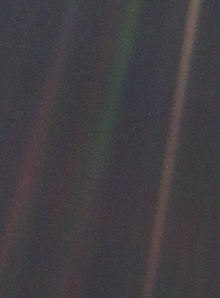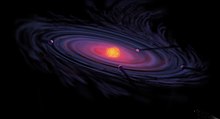Origin of the earth
The knowledge of planetology about the formation of the earth comes from geological findings, from the investigation of meteorites and lunar rocks as well as astrophysical data, for example on the abundance of solar elements.
In a larger context, the history of the creation of the earth is linked to the history of the universe and the Milky Way system in general, as well as to the history of our solar system in particular.
prehistory

The solar system emerged from a compression in a larger molecular cloud , which had recently been enriched with heavy elements from a nearby supernova explosion. Due to its gravity, the cloud collapsed within about 10,000 years, see star formation . In the accretion disk around the protostar , at temperatures more than 1300 K, condensed first large aluminum calcium and silicates . As could be determined with the help of uranium-lead dating , this happened almost 4.57 billion years ago. It is not known whether and how the dust then flocculated or how it could otherwise quickly sink into the central plane of the protoplanetary disk . There is also speculation about how and how quickly chunks one to ten meters in size were created. In any case, these then collected more dust through their gravity and grew into millions of planetesimals , some of which were kilometers in size. Below this size, collisions were not very violent because the movement of the chunks was still dampened by the gas (“A planetesimal is a solid object arising during the accumulation of planets whose internal strength is dominated by self-gravity and whose orbital dynamics is not significantly affected by gas drag. “) The planetesimals moved more independently, collided more violently and also more frequently due to gravitational focusing: the larger a planetesimal, the more spaciously it could collect chunks and underdeveloped planetesimals that would have escaped it on a straight path. In a race lasting a few millennia, protoplanets hundreds of kilometers in diameter were formed. They had used up small planetesimals or placed them in Jupiter's path.
Protoplanet collision cascade
The further growth happened hierarchically through increasingly rare collisions between ever larger bodies. With the mass of the collision partner, the released gravitational binding energy per unit of mass and thus the temperature after the impact also increased. From around 2000 ° C, the material first separated ( differentiated ) locally according to chemical preferences into core and shell material,
- Iron smelting, in which the siderophilic (Greek: iron loving) elements accumulated (see Goldschmidt classification ) and
- Melting silicate in which the lithophilic (Greek: stone loving) elements accumulated.
The much denser iron droplets formed puddles at the bottom of the melt. In later collisions, some bodies fragmented and released iron meteorites , witnesses to this early differentiation.
The warming from radioactive decay of 26 Al contributed significantly only to the smaller planetesimals that had not become part of the planets. The asteroid (4) Vesta is an example. The larger collisions, on the other hand, led to magma oceans in which iron cores were formed or previously existing iron cores fused together. The differentiation of the protoplanets took place on a timescale of a few million years, dated using the hafnium-tungsten method, also on Martian meteorites.
Proto-earth also grew mainly through collisions with not much smaller protoplanets. According to the collision theory , the moon was formed as a result of the last major impact . The hypothetical protoplanet or comet is called Theia and must have been between the size of the Moon and Mars . Theia's iron core has connected to that of the earth and parts of the mantle of the Proto-Earth and of Theia were thrown into the orbit from which the moon was formed. That happened sometime 30 to 50 million years after the dusty phase. The bombardment of smaller bodies had already subsided; in any case, afterwards hardly any iron can have seeped through the mantle (less than 1% of the core mass), as shown by analyzes of the hafnium - tungsten decay series of early archaic rocks.
Development of the jacket temperature
The earth's mantle , which was partially melted again by the impact of Theia, solidified, possibly within a few million years, from the inside out. The recent discovery of cladding material from this period (differentiation age), which was previously removed from cladding convection directly above the metallic core and now rises as a plume, questions the previous doctrine according to which the cladding has solidified homogeneously mixed. In any case, the thermal and chemical stratification was so stable that at least in the first half of the Hadaik the earth's mantle was stably stratified. Since there is no tectonics without mantle convection , no continental crust can form, as this requires a stronger differentiation of the crust. Ever earlier references to continental crust (and liquid water, see zircon in geology , TTG complex and origin of terrestrial water ) were therefore problematic. Due to tectonics, the thickness of the oceanic crust had grown so much after more than 100 million years that the mafic crust itself was subjected to further differentiation for the first time.
Later in the Hadaic era, deep in the earth's mantle, the temperature had risen to such an extent due to radioactive decay heat that mantle convection began, possibly not at full depth. The transition from chemical to biological evolution will take place at the latest during this period . In any case, in the oldest preserved crustal parts, so-called cratons , from the end of the Hadaic era four billion years ago, the depletion of C-13 compared to C-12 that is typical for life can be found in places .
The maximum of the mantle temperature falls roughly in the middle of the Archean. The area of the continental crust is increasing rapidly.
On the surface
Soon after the formation of the first crust, the planet was mostly covered by water and because of the young sun, which was still weak at the time , relatively cool and possibly icy. Among the small bodies that were still more common at the time, there were some more than 100 km in diameter per million years - not large enough to globally wipe out life, if it already existed, but large enough to end global icing itself through a temporarily immense greenhouse effect .
A little later, at the beginning of the Archean , living beings with oxygenic photosynthesis appeared for the first time , which produced elemental oxygen , which is bound to iron today as band ore . In the primordial atmosphere , however, the oxygen content only increased slowly in the last 50 million years of the Archean, until it jumped about 2.5 billion years ago. This is known as the Great Oxygen Disaster .
Further development
For further development see also:
Overview: phases of the earth's history
(Years in millions of years ago)

literature
- Rolf Meissner: History of the Earth. From the beginning of the planet to the beginning of life. 3. A. Beck, Munich 2010, ISBN 978-3-406-43310-8 .
Individual evidence
- ↑ a b c Michael Perryman: The Exoplanet Handbook . Cambridge University Press, 2011, ISBN 978-0-521-76559-6 , pp. 225f, limited preview in Google Book Search.
- ^ CT Russell et al .: Dawn at Vesta: Testing the Protoplanetary Paradigm . Science 336, 2012, pp. 684-686, doi : 10.1126 / science.1219381 ( online ).
- ↑ T. Kleine et al .: 182 Hf– 182 W isotope systematics of chondrites, eucrites, and martian meteorites: Chronology of core formation and early mantle differentiation in Vesta and Mars . Geochimica et Cosmochimica Acta 68, 2004, pp. 2935-2946, doi : 10.1016 / j.gca.2004.01.009 .
- ^ William K. Hartmann, Donald R. Davis: Satellite-sized planetesimals and lunar origin . In: Icarus . Volume 24, number 4, 1975, pp. 504-515, doi : 10.1016 / 0019-1035 (75) 90070-6 .
- ↑ G. Caro, T. Kleine: Extinct Radionuclides and the Earliest Differentiation of the Earth and Moon , pp. 9-51 in: Anthony Dosseto et al. (Hrgb): Timescales of Magmatic Processes: From Core to Atmosphere , Blackwell, 2011, ISBN 978-1-4443-3260-5 , limited preview in the Google book search.
- ↑ DC Rubie et al .: Formation of Earth's Core (PDF; 883 kB), chap. 9.03 in: Gerald Schubert (ed.): Treatise on Geophysics , Elsevier, 2007, ISBN 978-0-444-52748-6 . P. 68, fig. 9b.
- ^ Xuan-Ce Wanga et al .: Early differentiation of the bulk silicate Earth as recorded by the oldest mantle reservoir . Precambrian Research 238, 2013, pp. 52-60, doi : 10.1016 / j.precamres.2013.09.010 .
- ↑ Thorsten J. Nagel et al .: Generation of Eoarchean tonalite-trondhjemite-granodiorite series from thickened mafic arc crust . Geology, 2012, doi : 10.1130 / G32729.1 .
- ↑ Kenneth Chang: A New Picture of the Early Earth . In: The New York Times , December 1, 2008. Retrieved January 5, 2013.

